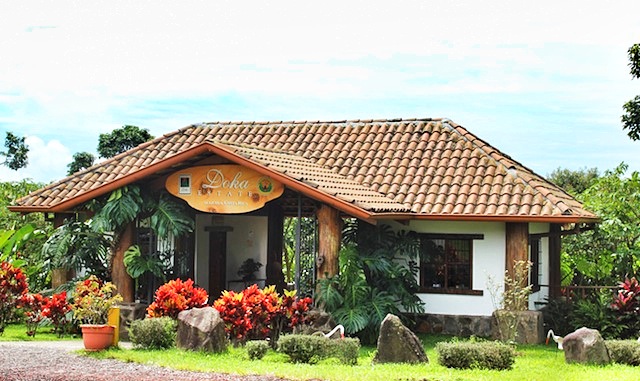
Located on the fertile slopes of the Alajuela Poas Volcano, the Doka Coffee Estate is widely known throughout Costa Rica and the world for its high quality Arabica coffee. The rich soil, ideal altitude and climate create the perfect conditions for growing coffee and other tropical plant species that protect and foster the well-being of the coffee trees. Owned by the Vargas family for three generations, the plantation still primarily operates using many of the milling techniques that were used when the farm first opened. We toured the estate to learn more about the process of how coffee gets from verdant plantations to our cup.
Seeds are planted in tiny planters and remain there for three months until they are strong enough to be transferred to normal pots. The seedlings remain in pots for approximately one year before they are transferred to the plantation where it takes four years to reach maturity. After 25 years, when the coffee trees no longer produce high quality beans, they are cut down and replaced with younger trees.
When the skin of the berries turn a vibrant red, they are ripe and ready to be picked , which is done all by hand at Doka. More than 400 workers tend to the 1,600 hectares of coffee plants during harvest season. Pay is low, but full housing is provided for the workers and their families who mainly hail from Nicaragua.
Many fruit trees, such as banana, mango and avocado are planted among the coffee plantation to lure pests away from the coffee berries.
Once the berries are harvested, the beans are extracted from the skin and sent to the “Receiving” area of the mill, where they are funneled into a large vat filled with water. The high quality beans sink to the bottom and the lesser quality, which are less dense, float to the top. The denser beans are then funneled to a different part of the mill where they are left to ferment for 40 hours.
The beans are then transferred to an area outside where they are shifted every 45 minutes for four days as they dry in the sun. (During the rainy season, the coffee is sometimes dried in the mill, a process that is avoided when possible as it does not render the same delicious flavor as when the beans are dried in the sun).
Once the beans are dry, they are placed in bags and stored for three months in a dry room before they are removed from their natural parchment casing and exported for roasting. All the beans — from the beginning of the milling process to the end — are used.
The lighter-colored beans are considered the highest quality (those that have been dried in the sun are considered the best) and the mix of light and dark-colored beans are of lesser quality. At Doka, 70 percent of the beans are sold to companies such as Starbucks, Pete’s Coffee and Green Mountain Coffee (where they are usually blended with lesser quality beans) and 30 percent are roasted in house for the restaurant on property and sold locally in Costa Rica.